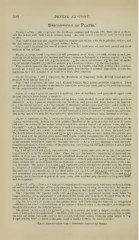Page 494 - My FlipBook
P. 494
504 DENTAL ANATOMY.
Descriptions of Plates.^
Plate I.—Figs. 1 and _' represent the deciduous incisors and cuspids, with their labial surfaces,
and the molars with their buccal surfaces facing. Also the noinial number of roots for these teeth
in situ.
Figs. 3 and 4 represent the superior incisors, cuspids, and molars with their palatine surfaces, and
the full inferior set with their lingual surfaces facing.
Figs. and 6 represent the mesial surfaces of the full deciduous set, aud both mesial and distal
surfaces of the molars.
Plate II.—Figs. 1 and 'i represent the full permanent set of thirty-two teeth, sixteen in each jaw,
with the labial surfaces of the incisors and buccal surfaces of bicusjjids and molars exposed: a a, the
central incisors, right and left; b h, the laterals; c c, the cuspids or canines; (/ rf, the first bicuspids;
e e, the second bicuspids ff^ the first molars ; g tj, the second molars ; li A, the third molars.
;
Figs. 2 and 4 repre.sent the anterior teeth, incisors, and cuspids, with their cutting edges notched,
as they are usually seen in the newly-erupted teeth, this uneven or notched appearance usually dis-
appearing in a few months, or at most in a year, after eruption.
Plate III.—Figs. 1 and 2 represent the deciduous or temporary teeth divided longitudinally
through their lateral diameter.
Figs. 3 and 4 represent the same teeth divided through their antero-posterior diameters. These
cuts give a very accurate idea of the relative size of the crown and roots, aud of the position occupied
by the pulp-chamber in the same.
Plate IV.— Fig. 3 gives in contrast a sectional view of deciduous and permanent upper teeth
divided through their lateral diameters.
Fig. 4, a sectional view of the corresponding lower teeth divided through their antero-posterior
diameters. «, 6, c, represent, respectively, the deciduous and permanent front incisors in contrast;
d, e,f, the lateral incisors ; g, h, i, the cuspids ; k; deciduous molars, upper and lower ; and /, in, the suc-
cessors to the deciduous molars, the bicuspids; ii,o represent i)ermanent molars. c,J',i,m,o have
dotted lines, indicating the thickness of enamel removed l)y wear, atrophy of the cementum, and reduc-
tion in the size of the pulp due to progressive calcification, these changes being incident to old age.
Plate V. represents in Fig. 1, letters a to k and ^ to A, the longitudinal or vertical sections of the
sixteen superior teeth, showing the labio-palatine diameter of the pulp-chamber and canal in crown
aud roots, the section of the molars being through the anterior buccal and palatine roots, while the
bicuspids d e a.udd_e illustrate the result of such a compression of the fang or root as to divide the
pulp-chamber into two canals—a condition which .so frequently exists in these flattened roots.
The double-lettered series, (/'/ to h/i and ihi to hji, represent in the molars a section through the pos-
terior buccal and the palatine roots, from which is quite readily recognized the slightly greater lateral
diameter of the pulp-chamber in the crown and the larger canal in the posterior buccal root over that
in the anterior buccal root, while the bicuspids lettered e e dd and d d <; f illustrate a modified pulp-
chamber and canal, with bifurcation of the root in one, these being cut through a diflereut axis or plane
from the single-lettered series.
Fig. 2, letters a to h and ato h, represents the sixteen inferior teeth with the section through their
long diameters, as in the superior series. These incisors illustrate the compressed or flattened con-
dition of their roots in contrast with the cylindrical character of the roots of the superior incisors,
while the bicuspids d e and d_e illustrate the siuglene.ss of their pulp-chamber and the cylindrical con-
dition of their roots as in contrast with' the flattened or compressed condition of the roots of the supe-
rior bicuspids. The molars /, g, //, and f", g, h represent sections through the anterior root, illustrating
its compressed condition and divided pulp-chamber in the first and second molar, and a somewhat
flattened one in tlie anterior root of the third molar ff, g g, k )i, and /'/, g g, h li represent the single
;
and cylindrical pulp-chamber in the posterior root of the inferior molars, while b h, c c and a n.h b
represent the incisors and cuspids of the same series, with modified pulp-chambers arising from modi-
fied development.
Plate VI. —Fig. 1, from a to h and « to^, represents the superior teeth, with transverse or horizon-
tal section through the base of the pulp-chamber in the crown, viewing the entrance to the canals of
the .several roots, while the same letters in Fig, 2 represent the inferior series in the same manner.
Fig. 8 represents the superior teeth, with the transverse or horizontal section made below the
largest diameter of the pulp-chamber and through the canals after they have diverged from the cen-
tral chamber, but before the roots into which they run have in the molars bifurcated.
Fig. 4 in like manner represents the inferior series, well illustrating the flattened or compressed
coiidition of the canal in anterior roots of the molars and the division of the chamber, as is frequently
found in the roots of the inferior incisors.
The letters ) represent the relative shapes, whether circular,
oval, or flattened, of the pulp-canal in the roots of the sni)erior centrnl and lateral incisors, the cuspids,
the first and second bicuspids, and the first, second, and third molars, while the same letters in Fig.
4 represent the relative shapes of the pulp-canal in similar teeth in the inferior series.
1 These plates are taken from v. Carabelli's Anatomic des Mtmdes.


